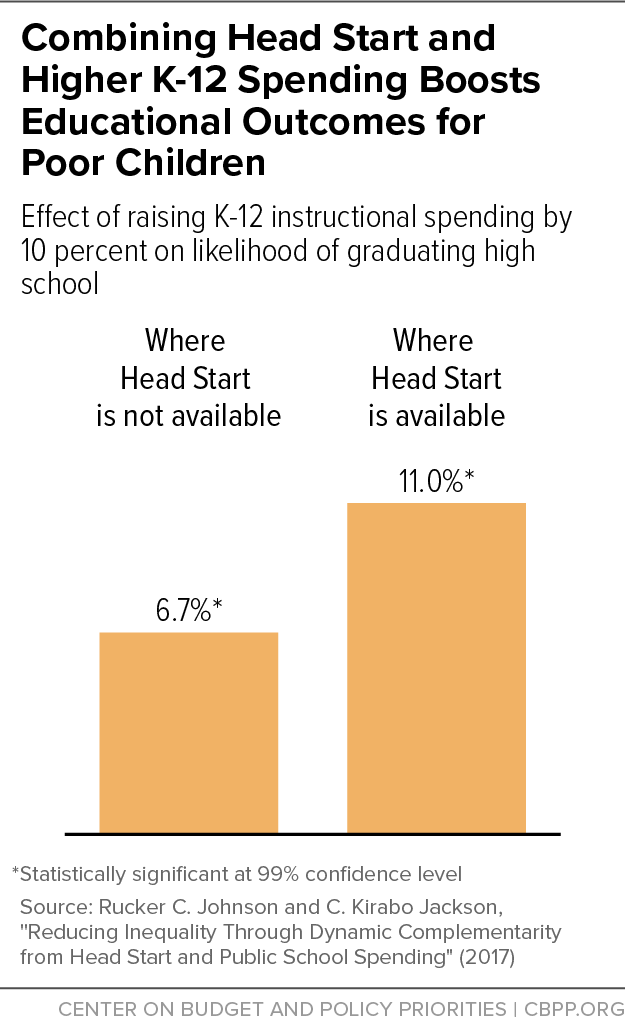- Home
- State Budget And Tax
- Research Note: Combining Early Education...
Research Note: Combining Early Education and K-12 Investments Has Powerful Positive Effects
Investments in early childhood and K-12 education are known separately to improve outcomes for low-income children, but evidence suggests their combined impact can be especially strong — strong enough to “effectively break the cycle of poverty,” according to a recent study by Rucker Johnson from the University of California, Berkeley and Kirabo Jackson from Northwestern University.[1]
Investments in early education produce the greatest dividends when followed by higher K-12 spending.Using careful statistical techniques and nearly 50 years of survey data, Johnson and Jackson tracked how rapidly changing geographic variations in K-12 education funding and access to the federally funded Head Start program interacted to influence low-income children’s outcomes. The authors find that investments in early education produce the greatest dividends when followed by higher K-12 spending. Similarly, K-12 spending is more effective when preceded by access to Head Start.[2] In both cases, the effects on children’s education attainment, and adult wages, poverty, and incarceration rates are significantly stronger and more positive when the interventions are combined than the sum of each program’s effect alone. The combined effect of these investments was large — comparable in magnitude to the average gap in outcomes between poor and non-poor children.
Pairing investments boosts educational outcomes. Lifting K-12 funding by 10 percent (from the national average) in a county without Head Start boosts the probability that a child living in poverty will graduate from high school by nearly 7 percentage points, the study found. The same increased level of K-12 funding, however, in a county with Head Start increases the likelihood that a child living in poverty will graduate high school by 11 percentage points. (See Figure 1.) Similarly, when looking at average years of completed education, the study found “the effect of K-12 spending is more than twice as large among poor individual[s] exposed to Head Start [as] those who are not.”[3] In short, combining these two investments in sequence greatly enhances poor children’s educational outcomes. (Increasing K-12 funding also had positive, though somewhat smaller, effects on outcomes for non-poor children.)
Combining investments in Head Start with increases in K-12 funding similarly improves other outcomes. Low-income children who are exposed to both earn 17 percent higher wages by age 30, are 12 percentage points less likely to experience poverty in adulthood, and are 5 percentage points less likely to be incarcerated than those who attended schools receiving just the higher K-12 funding without having had the preparation of Head Start — illustrating Head Start’s stronger effects in a setting of higher-than-average school spending. By contrast, in the context of K-12 spending that’s 10 percent below average, the authors estimate that Head Start’s effects are far smaller and no longer statistically significant.
Wage outcomes provide further evidence that the effect of the two interventions together is greater than the sum of the parts. Head Start and higher K-12 spending magnify each other’s effects. For example, Head Start raises poor children’s adult wages by 2.7 percent when coupled with K-12 spending 10 percent below the average, by 9.8 percent with average-level spending, and by 17 percent when coupled with K-12 spending at 10 percent above the average. Conversely, K-12 spending 10 percent above the average raises wages by about 13 percent in the absence of Head Start, but by nearly 21 percent when Head Start is available in the county.
The implications for poverty are dramatic. “The findings suggest that early investments in the skills of disadvantaged children that are followed by sustained educational investments over time can effectively break the cycle of poverty,” the authors say.[4] While the evidence shows that introducing Head Start lessens children’s later risk of poverty, its effect is muted without greater K-12 investment. When K-12 funding is 10 percent below the average, a child living in poverty and in a county with Head Start is not significantly less likely than one without Head Start access to become an adult living in poverty by age 30. When there is average-level K-12 spending, Head Start exposure reduces poverty by 8 percentage points. But when coupled with K-12 funding 10 percent above the average, Head Start reduces poverty by 12 percentage points. (See Figure 2.) That improvement is similar in size to the 13 percentage-point difference in adult poverty rates between children who grow up poor and those who did not start out poor.
The findings provide evidence that early and sustained investments in education can increase opportunities for poor children. But to achieve the best return on investment for Head Start and K-12 programs, federal, state, and local governments must spend adequately on both. Cutbacks in early education and K-12 spending, however, could undo progress.
Methodological Note
The analysis is particularly compelling because it takes advantage of large policy-driven changes in preschool and K-12 investment levels across a large number of locations.
To isolate the effect of Head Start from other community influences, the study looks closely at the timing of initial county-by-county rollout of Head Start from 1965 to 1980, comparing the adult outcomes of individuals who grew up in the same county but were exposed to different levels of Head Start spending because of their age. (For example, Head Start targets 4-year-olds, and children who reached age 4 the year their county introduced Head Start were likely similar to, but had far greater likelihood of participating in Head Start than, children who were 4 years old the previous year. In additional comparisons, the authors even compare siblings from the same family, some of whom had access to Head Start while others did not due to timing and age.)
To isolate the effects of K-12 spending, the authors focus on spending changes that resulted from statewide lawsuits in 28 states between 1971 and 2010 that forced states to provide more equitable education funding across school districts. Using data on approximately 8,000 children from the Panel Study of Income Dynamics, the study tracked the effect of both Head Start and K-12 interventions on individuals born between 1950-1976 and followed them through 2015. The approach for both interventions allows the authors to convincingly determine the effect of these investments, separate from other community and family influences.
These historical findings may or may not apply today, the authors caution. Spending more on services may not have as large a positive impact today because public investments in children’s education, preschool, and early pediatric care are higher in inflation-adjusted terms than they were in the 1960s-1980s, which may have helped address some of poor children’s most urgent needs. On the other hand, the authors note, greater spending might matter more today than during the period the authors studied because education matters more for opportunity, and the education spending gaps between poor and non-poor children remain wide.[5]
End Notes
[1] Rucker C. Johnson and C. Kirabo Jackson, “Reducing Inequality Through Dynamic Complementarity: Evidence Head Start and Public School Spending,” NBER Working Paper No. 23489, revised February 2018. (Paper has been accepted for publication in the American Economic Journal: Economic Policy.)
[2] Head Start “access” in this study means living in a county that spends the average amount for counties with Head Start (which was roughly $4,000 per poor 4-year-old child in the county in 2000 dollars), rather than in a county with no Head Start.
[3] Johnson and Jackson, p. 34.
[4] Ibid., p. 34. Also see Johnson and Jackson’s abstract.
[5] Ibid., pp. 40-41.


